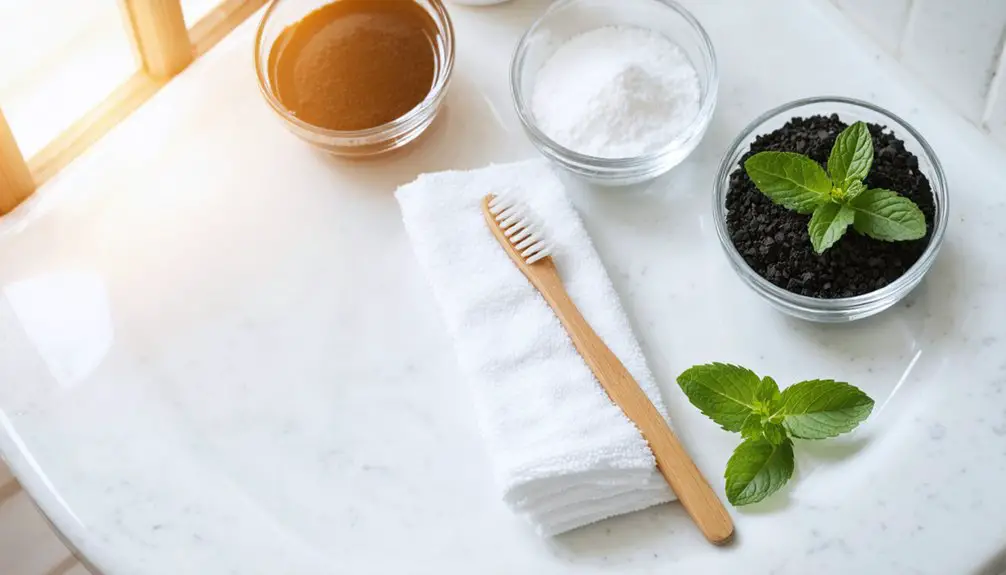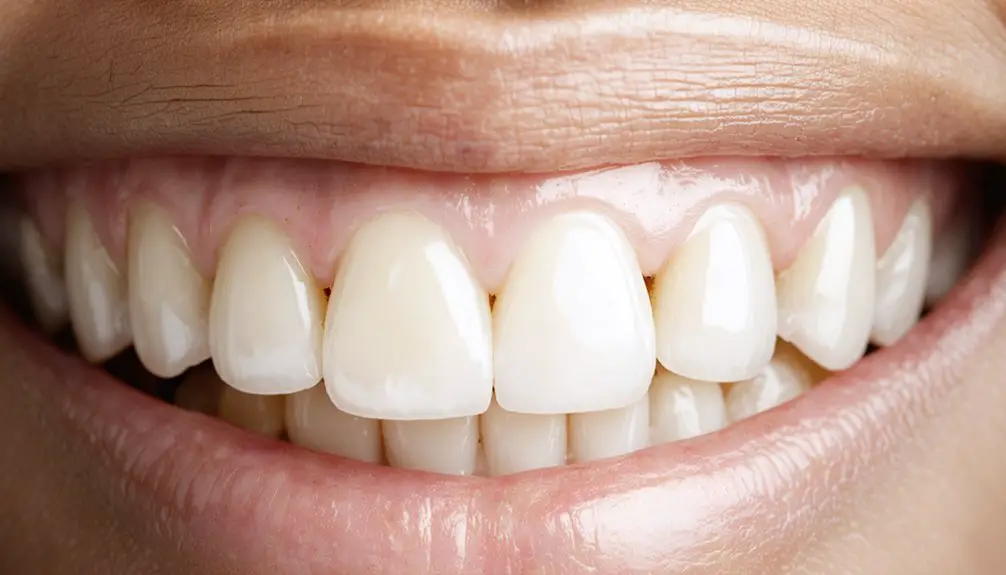You can safely whiten sensitive teeth using specially-formulated products with lower peroxide concentrations and built-in desensitizing agents. Start with professional-grade whitening toothpaste containing potassium nitrate, then progress to gentle overnight whitening kits with custom-fit trays or strips. Space out treatments to allow enamel recovery, and consider consulting your dentist for personalized recommendations. Understanding the right techniques and products will help you achieve a brighter smile without discomfort.
Key Takeaways
- Custom-fitted trays with low-concentration carbamide peroxide provide gradual whitening while minimizing sensitivity through controlled release technology.
- Professional whitening treatments incorporating desensitizing agents offer safer results under dentist supervision with adjustable peroxide levels.
- Whitening toothpaste containing potassium nitrate and nano-hydroxyapatite provides gentle stain removal while protecting sensitive teeth.
- At-home overnight whitening kits with 6% or less peroxide concentration allow safe, gradual results over 14-30 days.
- Natural whitening alternatives containing aloe vera or coconut oil offer gentler stain removal for extremely sensitive teeth.
Understanding the Root Causes of Tooth Sensitivity
While many people experience tooth sensitivity, understanding its biological mechanisms helps explain why certain triggers cause discomfort.
Your tooth sensitivity often stems from exposed dentinal tubules, which can occur when you lose protective enamel or experience gum recession. These tubules connect to your tooth’s nerve endings through a fluid-filled system. Studies show that tooth sensitivity affects approximately 74% of the general population.
At a molecular level, your teeth contain specialized cells called odontoblasts that feature TRPC5 proteins. These proteins act as temperature sensors, particularly responding to cold stimuli. Research shows that oil of cloves can help reduce sensitivity by blocking these TRPC5 proteins.
When activated, they trigger calcium influx and nerve signaling to your brain, resulting in pain. This sensitivity becomes more pronounced if you have inflamed pulp or damaged teeth.
Understanding these mechanisms is vital for your dental health, as it helps explain why certain treatments may work better for your specific sensitivity issues.
The Science Behind Gentle Teeth Whitening
Your teeth’s sensitivity during whitening depends on peroxide concentration levels, with gentler options like carbamide peroxide releasing active ingredients more slowly than hydrogen peroxide.
To protect your enamel during whitening, look for products containing stabilizers like glycerin and desensitizing ingredients such as potassium nitrate and fluoride. The chemical breakdown process transforms stain molecules into smaller, colorless compounds.
You’ll experience less nerve sensitivity when using these specially-formulated gentle whitening products, which create a barrier while still effectively breaking down stain molecules through controlled oxidation. Professional treatments using LED light-activated systems can provide enhanced whitening results while maintaining gentleness on sensitive teeth.
Understanding Peroxide Action Levels
The science of teeth whitening revolves around peroxide compounds and their remarkable ability to break down stains through oxidation reactions. When you apply whitening gel, peroxide effectiveness depends on its concentration – ranging from gentle 3% solutions to powerful 35% formulations. Higher concentrations work faster but may cause more sensitivity. Light and heat can accelerate the whitening process by enhancing peroxide breakdown.
Within 5-15 minutes of application, peroxide penetrates your enamel and dentin, releasing oxygen that chemically alters embedded stains. The enamel functions as a semipermeable membrane allowing the whitening gel to effectively reach stained areas.
Modern whitening formulations include stabilizers to maintain peroxide potency and desensitizing agents like potassium nitrate and fluoride to protect sensitive teeth. For gentler treatment, lower concentrations (6-10%) combined with desensitizers offer a balanced approach, providing effective whitening while minimizing discomfort.
The key is finding the right peroxide level that matches your sensitivity threshold.
Enamel Protection During Whitening
Understanding how whitening agents interact with tooth enamel becomes central to achieving safe, effective results. Your enamel’s complex structure of hydroxyapatite crystals requires careful protection during whitening procedures.
Since enamel is the hardest tissue in the body, it can withstand controlled whitening treatments.
Modern whitening product formulations incorporate pH-balancing agents to prevent demineralization while the peroxide breaks down stains.
Key enamel preservation techniques include using neutral or slightly alkaline whitening agents and spacing treatments appropriately to allow remineralization. The active ingredient in most whitening products is hydrogen peroxide which penetrates the enamel to break down stain compounds.
You’ll want to avoid acidic foods and beverages post-treatment, as your enamel becomes temporarily more vulnerable.
Professional supervision guarantees proper monitoring of your enamel’s condition throughout the process.
Additionally, using remineralizing products containing fluoride, calcium, and phosphate helps maintain your enamel’s integrity during and after whitening treatments.
Nerve Sensitivity Control Methods
While pursuing a brighter smile, managing tooth sensitivity becomes essential for successful whitening outcomes. You can minimize nerve irritation through several proven desensitizing techniques.
Professional treatments employ advanced whitening techniques that balance effectiveness with comfort. Start using desensitizing toothpaste containing potassium nitrate or fluoride at least two weeks before your whitening treatment to build protective benefits. Lower concentration products are safer alternatives that still effectively whiten while minimizing discomfort.
Your dentist can customize treatments by adjusting peroxide concentrations and exposure times to match your sensitivity level. They’ll often apply protective barriers or specialized formulations to shield nerve endings during the process.
For additional comfort, you can take acetaminophen before treatment, but never apply pain medication directly to your gums.
Remember to avoid extremely hot or cold foods during whitening, and don’t overuse whitening products. Following these protocols helps guarantee a comfortable whitening experience while protecting your teeth’s nerve health.
Professional Treatment Options for Sensitive Smiles
People with sensitive teeth can safely achieve a brighter smile through professional whitening treatments specifically designed to minimize discomfort.
During dental professional consultations, you’ll receive customized treatment plans that consider your sensitivity level and whitening goals.
Your options include in-office laser whitening, which combines controlled light energy with specialized gels for faster results, or custom-fitted trays with lower-concentration bleaching agents for gradual whitening at home.
Both approaches incorporate desensitizing agents containing potassium nitrate or fluoride to block nerve sensitivity during treatment.
Your dentist will monitor your progress closely, adjusting treatment intensity and duration based on your comfort level.
They’ll select appropriate bleaching concentrations and may recommend shorter, more frequent sessions to guarantee you achieve ideal results while maintaining comfort throughout the process.
At-Home Whitening Solutions That Won’t Hurt

If you’re seeking gentler whitening options, overnight whitening kits designed for sensitive teeth offer a controlled, gradual approach to brightening your smile while you sleep.
You’ll find these kits typically include custom-fit trays with mild peroxide formulations that work over 6-8 hours, allowing for deeper penetration at lower concentrations that minimize discomfort.
Following a weekly treatment schedule helps you maintain consistent results while giving your teeth recovery time between applications to prevent sensitivity flare-ups.
Safe Overnight Whitening Kits
Looking for a gentle way to whiten your teeth while you sleep? Today’s overnight whitening kits offer safe ingredients and proven overnight effectiveness for those with sensitive teeth.
Carbamide peroxide formulations provide gradual whitening with less irritation than traditional treatments.
Choose kits designed specifically for sensitive teeth that feature:
- Flexible, soft trays or strips with no-slip grips for comfortable overnight wear
- Natural whitening agents like aloe vera or coconut oil for gentler stain removal
- Controlled-release technology that minimizes gum and tooth sensitivity
- Desensitizing ingredients combined with whitening agents for maximum comfort
You can expect noticeable results of 1-2 shades lighter within 14-30 days when following the recommended treatment schedule.
Remember to consult your dentist before starting any whitening regimen, especially if you have existing dental issues or severe sensitivity.
Weekly Treatment Schedule Plans
While achieving a brighter smile requires patience, following a carefully structured weekly treatment schedule can help you whiten your teeth without triggering sensitivity.
Begin with daily applications for 3-4 days to assess your tolerance, then adjust your whitening frequency to 2-3 sessions per week. Start each treatment session at 15-20 minutes and gradually increase the treatment duration toward the recommended maximum as your comfort allows.
Choose whitening products with 6% or less peroxide concentration and built-in desensitizing agents.
You’ll want to space out your sessions to allow proper recovery time between treatments. Remember to use sensitivity toothpaste before and after sessions, and avoid harsh foods and beverages post-treatment.
If you experience persistent discomfort, reduce frequency or consult your dentist for personalized guidance.
Choosing the Right Whitening Toothpaste
Selecting the right whitening toothpaste for sensitive teeth requires careful consideration of key ingredients and abrasiveness levels.
Look for products containing potassium nitrate for sensitivity management and nano-hydroxyapatite for enamel strengthening. You’ll want to choose toothpaste with low RDA scores to protect your sensitive teeth while achieving a brighter smile.
When evaluating whitening toothpaste ingredients, consider these essential factors:
- Verify the presence of desensitizing agents like potassium nitrate
- Check for gentle whitening components that avoid peroxide
- Confirm fluoride content for enamel protection
- Verify low-abrasion formulas with minimal RDA values
For best results, focus on products with the ADA Seal of Acceptance, as these have been tested for both safety and effectiveness in whitening while managing sensitivity.
Natural Alternatives for a Brighter Smile

If you’re seeking a gentle approach to teeth whitening, oil pulling with coconut oil offers a time-tested method that naturally reduces plaque and bacteria through its antimicrobial properties.
You’ll find several effective whitening ingredients right in your kitchen cabinet, including baking soda and food-grade hydrogen peroxide, which can be combined to create a mild yet effective whitening paste.
When using these natural alternatives, you’ll need to be consistent with your routine while following proper dilution ratios and application techniques to achieve gradual, safe results.
Oil Pulling Benefits Explained
Although oil pulling has gained popularity as a natural teeth whitening method, scientific evidence doesn’t support its effectiveness for achieving a brighter smile.
While swishing with oils like coconut or sesame won’t greatly whiten your teeth, research shows this ancient practice does offer some oral hygiene benefits.
Here’s what you can realistically expect from oil pulling:
- Reduces bacterial counts in saliva, providing mild antimicrobial effects
- May help relieve dry mouth and throat irritation symptoms
- Increases saliva production, which naturally cleanses your mouth
- Can serve as a gentle complement to regular brushing and flossing
Consider oil pulling as an optional addition to your oral care routine rather than a replacement for proven dental practices or professional whitening treatments.
Always maintain proper dental hygiene and consult your dentist for effective whitening solutions.
Safe Kitchen Cabinet Remedies
When searching for gentler alternatives to commercial whitening products, your kitchen cabinets may hold several natural solutions that can help brighten your smile.
The baking soda benefits include its mild abrasive properties that effectively remove surface stains without damaging enamel when used properly. Mix it with hydrogen peroxide for enhanced whitening, but limit use to once or twice weekly.
Charcoal effectiveness stems from its ability to absorb surface stains from coffee, tobacco, and food. Apply it gently to avoid enamel wear, using only once or twice per week.
Other kitchen-based options include diluted apple cider vinegar as a mouth rinse or mashed strawberries for their natural malic acid content.
Always rinse thoroughly after using any natural whitening remedy to protect your enamel and prevent sensitivity.
Tips for Maintaining White Teeth Without Pain
Since maintaining white teeth often triggers sensitivity concerns, adopting gentle yet effective methods can help you achieve lasting brightness without discomfort. Understanding common sensitivity triggers and focusing on enamel remineralization will protect your smile while preserving its whiteness.
Protect your smile by choosing gentle whitening methods and focusing on enamel health – the key to maintaining brightness without sensitivity.
To maintain white teeth comfortably, follow these essential practices:
- Use desensitizing toothpaste with stannous fluoride twice daily to strengthen enamel while gently polishing away stains.
- Rinse immediately after consuming staining beverages and acidic foods to prevent enamel erosion.
- Choose natural whitening ingredients like baking soda combined with low-peroxide formulas for gradual brightening.
- Schedule regular professional cleanings and consult your dentist about personalized maintenance plans that won’t aggravate sensitivity.
These approaches help you maintain your bright smile while protecting your teeth’s natural defenses against discomfort.
Best Practices When Using Whitening Strips

To achieve ideal results with teeth whitening strips while minimizing potential discomfort, proper application technique and adherence to safety guidelines are essential.
Begin whitening strip application by ensuring your teeth are dry, then carefully align the gel side against your teeth at the gum line. Press firmly to eliminate air pockets and fold excess material behind your teeth for complete coverage.
You’ll want to follow the product’s specific wear time, typically 30 minutes, and don’t exceed recommended duration even if you’re keen for faster results. Set a timer to track your session accurately.
For discomfort management, avoid eating or talking while wearing strips, and if you experience sensitivity, consider repositioning them. Always select ADA-approved products and maintain consistent daily use as directed, usually for 1-2 weeks.
How to Protect Your Enamel While Whitening
Protecting your tooth enamel during whitening procedures requires a careful balance between achieving desired results and maintaining dental health. When comparing whitening products, opt for formulations with lower peroxide concentrations to minimize enamel stress.
These enamel preservation techniques will help safeguard your teeth during the whitening process:
- Use fluoride treatments before and after whitening sessions to strengthen enamel and reduce demineralization.
- Wait at least 30 minutes after whitening before brushing to prevent damage to temporarily softened enamel.
- Choose custom-fitted trays for at-home treatments to limit peroxide contact with sensitive areas.
- Avoid acidic foods and beverages immediately before and after whitening treatments.
Remember to maintain regular dental check-ups to monitor your enamel’s condition and adjust your whitening routine accordingly.
Your dentist can recommend specific products that align with your enamel’s sensitivity level.
Building a Safe Whitening Routine for Sensitive Teeth

Having sensitive teeth doesn’t mean you can’t achieve a brighter smile – it just requires a thoughtful, systematic approach. Start by consulting your dentist to create a personalized plan that considers your sensitivity level and dental health.
Begin with a sensitivity-formulated whitening toothpaste to build tolerance before advancing to more intensive treatments. Monitor your teeth’s response and adjust whitening frequency accordingly.
Incorporate desensitizing techniques, such as specialized toothpaste or gels, alongside your whitening routine. Space out your treatments to allow recovery time between sessions, and maintain excellent oral hygiene to protect your enamel.
If you experience increased discomfort, reduce treatment frequency or pause your whitening regimen. Remember to track your progress and communicate any concerns with your dental professional to guarantee a safe, comfortable whitening journey.
Frequently Asked Questions
How Long Should I Wait After Eating Before Using Whitening Products?
Like a sensitive flower, your teeth need time to rest. You’ll want to wait 2-3 hours after eating before using whitening products to minimize teeth sensitivity and maintain healthy eating habits.
Can I Drink Coffee While Undergoing a Teeth Whitening Treatment?
You shouldn’t drink coffee during teeth whitening treatment. Wait at least 48-72 hours after each session, as coffee consumption greatly reduces whitening effectiveness and can stain your temporarily porous enamel.
Will Sensitive Teeth Eventually Become Less Sensitive After Whitening Treatments Stop?
Yes, your teeth sensitivity will typically resolve within days to weeks after whitening duration ends, as long as you’ve followed proper protocols and don’t have underlying dental conditions.
Are Whitening Results Permanent, or Do They Require Periodic Touch-Ups?
Your whitening results aren’t permanent. You’ll need periodic touch-ups every 6-12 months for maintenance, depending on your chosen method, lifestyle habits, and how well you protect your teeth from stains.
Can Medications Affect the Success of Teeth Whitening Treatments?
Yes, your medications can considerably impact whitening effectiveness. Certain drugs cause internal tooth discoloration and medication interactions may reduce treatment success, requiring your dentist to adjust whitening protocols accordingly.
References
- https://www.smilesbylorino.com/teeth-whitening-for-sensitive-teeth-gentle-solutions-that-work/
- https://www.blvddentistry.com/can-you-get-whitening-treatment-with-sensitive-teeth/
- https://supremiadentistry.com/the-5-best-ways-to-whiten-sensitive-teeth/
- https://www.sensodyne.com/en-us/oral-health-tips/whitening-sensitive-teeth/what-to-know/
- https://www.culvercitydentist.com/blogs/teeth-whitening/best-teeth-whitening-options-for-people-with-sensitive-teeth
- https://www.massgeneral.org/news/press-release/researchers-discover-why-cold-induces-tooth-pain-and-hypersensitivity-and-how-to-stop-it
- https://pmc.ncbi.nlm.nih.gov/articles/PMC3927677/
- https://pmc.ncbi.nlm.nih.gov/articles/PMC11326452/
- https://www.listerine.com/tooth-sensitivity/tooth-pain-causes
- https://professional.sunstargum.com/en-en/news-events/tooth-sensitivity-facts-and-research-for-professionals.html



